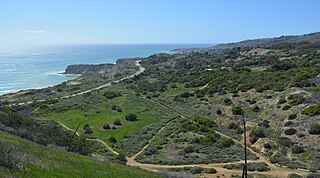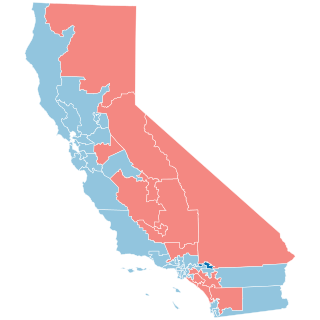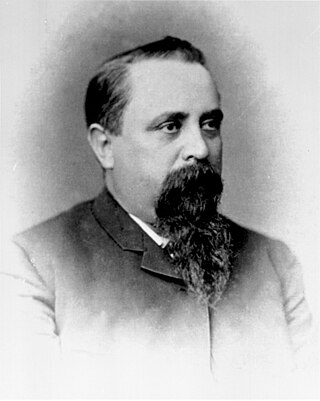Related Research Articles

The South Bay is a region of the Los Angeles metropolitan area, located in the southwest corner of Los Angeles County. The name stems from its geographic location stretching along the southern shore of Santa Monica Bay. The South Bay contains fifteen cities plus portions of the City of Los Angeles and unincorporated portions of the county. The area is bounded by the Pacific Ocean on the south and west and generally by the City of Los Angeles on the north and east.

Palos Verdes Estates is a city in Los Angeles County, California, United States, situated on the Palos Verdes Peninsula. The city was master-planned by the noted American landscape architect and planner Frederick Law Olmsted Jr. The city is located along the Southern California coastline of the Pacific Ocean.

Rancho Palos Verdes is a coastal city located in Los Angeles County, California atop the bluffs of the Palos Verdes Peninsula, neighboring other cities in the Palos Verdes Hills, including Palos Verdes Estates, Rolling Hills and Rolling Hills Estates. Rancho Palos Verdes is known for its dramatic views of the Pacific Ocean, Santa Catalina Island, and Los Angeles, as well as for its highly-ranked schools, extensive horse and hiking trails, and for being one of the wealthiest ZIP codes in the United States in terms of household income and property prices.

Rolling Hills is a city on the Palos Verdes Peninsula, in Los Angeles County, California, United States. Rolling Hills is a gated community with private roads with three entry gates. Homes are single-story 19th century California ranch or Spanish haciendas exemplified by architect Wallace Neff. Incorporated in 1957, Rolling Hills maintains a rural and equestrian character, with no traffic lights, multi-acre lots with ample space between homes, and wide equestrian paths along streets and property lines.

Torrance is a city in the Los Angeles metropolitan area located in Los Angeles County, California, United States. The city is part of what is known as the South Bay region of the metropolitan area. Torrance has 1.5 miles (2.4 km) of beachfront on the Pacific Ocean and a moderate year-round climate with an average rainfall of 12 inches (300 mm) per year. Torrance was incorporated in 1921, and at the 2020 census had a population of 147,067 residents. The city has 30 parks. The city consistently ranks among the safest cities in Los Angeles County. Torrance is also the birthplace of the American Youth Soccer Organization (AYSO).

Rolling Hills Estates is a city in Los Angeles County, California, United States. On the northern side of the Palos Verdes Peninsula, facing Torrance, Rolling Hills Estates is mostly residential. Incorporated in 1957, Rolling Hills Estates has many horse paths. The population was 8,067 at the 2010 census, up from 7,676 at the 2000 census. In 2018, the population rose to 8,141.

San Pedro is a neighborhood within the City of Los Angeles, California. Formerly a separate city, it consolidated with Los Angeles in 1909. The Port of Los Angeles, a major international seaport, is partially located within San Pedro. The district has grown from being dominated by the fishing industry, to a working-class community within the city of Los Angeles, to a rapidly gentrifying community.

The Palos Verdes Peninsula is a landform and a geographic sub-region of the Los Angeles metropolitan area, within southwestern Los Angeles County in the U.S. state of California. Located in the South Bay region, the peninsula contains a group of cities in the Palos Verdes Hills, including Palos Verdes Estates, Rancho Palos Verdes, Rolling Hills and Rolling Hills Estates, as well as the unincorporated community of Westfield/Academy Hill. The South Bay city of Torrance borders the peninsula on the north, the Pacific Ocean is on the west and south, and the Port of Los Angeles is east. As of the 2010 Census, the population of the Palos Verdes Peninsula is 65,008.

The Portuguese Bend region is the largest area of natural vegetation remaining on the Palos Verdes Peninsula, in Los Angeles County, California. Though once slated for development including the projected route of Crenshaw Boulevard, the area is geologically unstable and is unsuitable for building.
The Daily Breeze is a 57,000-circulation daily newspaper published in Hermosa Beach, California, United States. It serves the South Bay cities of Los Angeles County. Its slogan is "LAX to LA Harbor".

Rancho de los Palos Verdes was a 31,629-acre (128.00 km2) Mexican land grant in present-day Los Angeles County, California given in 1846 by Governor Pío Pico to José Loreto and Juan Capistrano Sepulveda. The name means "range of green trees". The grant encompassed the present-day cities of the Palos Verdes Peninsula, as well as portions of San Pedro and Torrance.

Don Manuel Domínguez (1803–1882) was a Californio ranchero, politician, and a signer of the Californian Constitution in 1849. He served as two terms as Alcalde of Los Angeles (mayor). He was one of the largest landowners in Southern California, having inherited Rancho San Pedro in 1825, one of the largest ranchos in California. He was one of the founders of the cities of Carson and Compton and of the fishing village of San Pedro. Today, California State University, Dominguez Hills and the communities of Rancho Dominguez, East Rancho Dominguez, and West Rancho Dominguez bear his family's name.

Rancho San Pedro was one of the first California land grants and the first to win a patent from the United States. The Spanish Crown granted the 75,000 acres (300 km2) of land to soldier Juan José Domínguez in 1784, with his descendants validating their legal claim with the Mexican government at 48,000 acres (190 km2) in 1828, and later maintaining their legal claim through a United States patent validating 43,119 acres (174.50 km2) in 1858. The original Spanish land grant included what today consists of the Pacific coast cities of Los Angeles harbor, San Pedro, the Palos Verdes peninsula, Torrance, Redondo Beach, Hermosa Beach, and Manhattan Beach, and east to the Los Angeles River, including the cities of Lomita, Gardena, Harbor City, Wilmington, Carson, Compton, and western portions of Long Beach and Paramount.
Torrance Transit is a transit agency primarily serving the South Bay region of Los Angeles County. In 2021, the system had a ridership of 2,161,800, or about 6,000 per weekday as of the second quarter of 2022.
The Palos Verdes Peninsula Transit Authority is the primary provider of mass transportation in the Los Angeles suburbs of Rancho Palos Verdes, Palos Verdes Estates, Rolling Hills, and Rolling Hills Estates, California. Six color routes provide local service, while Routes 225 and 226 both allow for connections in Torrance and Route 226 also continues into the Los Angeles district of San Pedro.
Pacific Unitarian Church is a Unitarian Universalist congregation located in Rancho Palos Verdes, California. It is a member of the Unitarian Universalist Association of Congregations, within the Pacific Southwest District. PUC was recognized as one of four "Breakthrough Congregations" in 2008, reflected in a $75,000 donation to Community Church UU of New Orleans. Membership as of 2019 is around 180 with weekly attendance averaging over 90 adults and children.

The Palos Verdes Peninsula Land Conservancy (PVPLC) is a non-profit organization that is based on the Palos Verdes Peninsula in southwestern Los Angeles County, California.

The 2014 United States House of Representatives elections in California were held on Tuesday, November 4, 2014, with a primary election on June 3, 2014. Voters elected the 53 U.S. representatives from the state of California, one from each of the state's 53 congressional districts. The elections coincided with the elections of other offices, including a gubernatorial election.

Jose Dolores Sepulveda Adobe is an adobe home built in 1818. It is located at the Rancho de los Palos Verdes in Torrance, California. The Jose Dolores Sepulveda Adobe was designated a California Historic Landmark on Jan. 03, 1944. The Jose Dolores Sepulveda Adobe was built by José Dolores Sepúlveda, his son was Mayor of Los Angeles from 1837 to 1848. José Dolores Sepúlveda’s father was José Loreto Sepúlveda (1764–1808). The location is now a private residence in Torrance. The original Adobe is gone, but current homeowner renovated the house to reflect the Rancho history. Rancho de los Palos Verdes means "range of green trees". The Rancho is now the present-day cities of the Palos Verdes Peninsula, as well as portions of San Pedro and Torrance.

The Sepúlveda family is a prominent Californio family of Southern California. Members of the family held extensive rancho grants and numerous important positions, including Alcalde de Los Ángeles, California State Assemblymen, and Los Angeles County Supervisor.
References
- 1 2 "Mayor Isen Climbs to New Heights With View Home". Palos Verdes Peninsula News. 14 December 1961. Retrieved 25 June 2019.
- 1 2 3 4 5 Stein, George (August 20, 1987). "Served the Longest in Top City Job: Albert Isen, Ex-Torrance Mayor, Dies". Los Angeles Times. Retrieved 25 June 2019.
- ↑ "San Pedran and Torrance Man Pass Bar Examination". San Pedro News Pilot. 4 December 1941. Retrieved 25 June 2019.
- ↑ "Albert Isen Opens Law Offices in Home Town". San Pedro News Pilot. 5 September 1933. Retrieved 25 June 2019.
- ↑ "Rippy Named Police Judge". San Pedro News Pilot. 24 January 1934. Retrieved 25 June 2019.
- ↑ "Group Starts Recall Move". San Pedro News Pilot. 10 May 1935. Retrieved 25 June 2019.
- ↑ "Announces Candidacy". Palos Verdes Peninsula News. 6 February 1958. Retrieved 25 June 2019.
- ↑ Gnerre, Sam (March 13, 2012). "Marlon Brando comes to Southwood". South Bay History [blog]. Daily Breeze. Retrieved 25 June 2019.